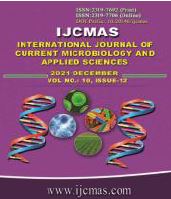


 National Academy of Agricultural Sciences (NAAS)
National Academy of Agricultural Sciences (NAAS)

|
PRINT ISSN : 2319-7692
Online ISSN : 2319-7706 Issues : 12 per year Publisher : Excellent Publishers Email : editorijcmas@gmail.com / submit@ijcmas.com Editor-in-chief: Dr.M.Prakash Index Copernicus ICV 2018: 95.39 NAAS RATING 2020: 5.38 |
The Annonagenus, consisting of 119 species, has been continuously researched and proven to have various pharmacological activities such as anticancer, antioxidant, anti-inflammatory, antibacterial and so on. Annona plants such as Annona cherimolia Mill, Annona Reticulate, Annona Squamosa, Annona muricata L have antioxidant, antimicrobial, anti-inflammatory, antihelmintic, antipyretic, antihyperglycemic, analgesic, wound healing, and cytotoxic effects caused by the presence of active compounds such as acetogenin, alkaloids. And terpenoids whose role as treatment or prevent anti-cancer. Active compounds in inhibiting or preventing cancer cells are mostly found in the leaves, seeds and fruit of the Annona plant. The anticancer or antitumor activity of bioactive compounds is related to the structure of these compounds. The large number of hydroxyl groups and supported by the hydroxyl position flanking the γ-lactone ring and the stereochemical arrangement of the THF ring determines the effectiveness of cytotoxic activity (the stereochemical arrangement of the THF ACG ring, threo/trans/erythro is more active than threo/trans/threo), the presence of hydroxyl groups at the tail of the ACG carbon chain and for alkaloids in the presence of 1,2-methylenedioxy and methylated nitrogen.
 |
 |
 |
 |
 |